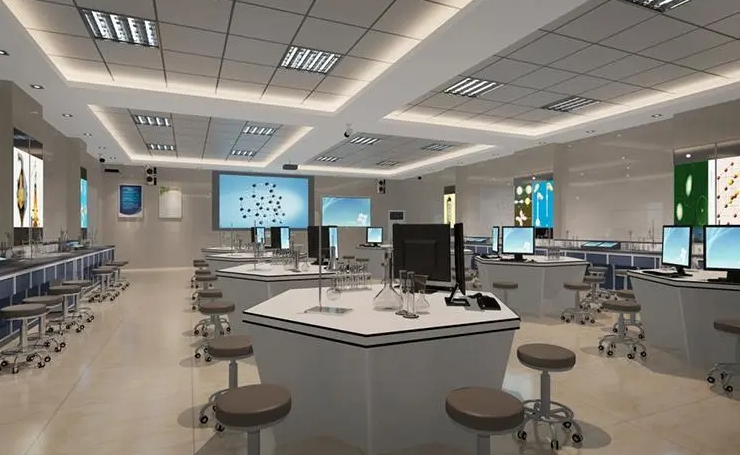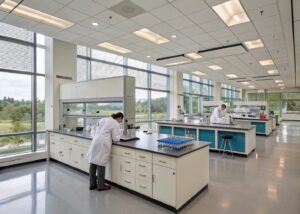Table of Contents
How to Design a School Lab: A Complete Guide for Contractors and Designers
The design of a school lab is crucial to both the success of teaching and the safety of students. Modern labs must not only support the curriculum but also provide a safe, efficient environment that fosters innovation. Whether you’re a contractor, architect, or designer, understanding the intricacies of school lab design will help you create spaces that meet educational needs and modern safety standards.
In this guide, we’ll walk you through the most important aspects of school lab design—from layout and utility planning to choosing the right materials for lab furniture and safety considerations. By focusing on these key points, you can ensure your lab designs are functional, durable, and adaptable for future advancements.
Assess the Lab’s Purpose and Functionality
Before diving into the design process, it’s essential to understand the specific needs of the lab. Different schools have different focuses, whether it’s chemistry, biology, physics, or multi-disciplinary labs. Each type of lab will have unique requirements in terms of equipment, utilities, and layout.
- Chemistry labs need advanced ventilation systems to handle fumes.
- Biology labs require specific water and drainage systems for experiments involving live organisms.
- Physics labs often need precise power supply setups for instruments.
By identifying the exact type of school lab, you can create a school lab design that maximizes functionality and safety.
Plan the Layout for Optimal Workflow
A well-designed school lab must accommodate smooth workflow and easy movement for both students and teachers. When creating the layout, keep the following in mind:
- Lab Zones: Divide the space into distinct zones for preparation, experimentation, and cleanup. This ensures that each area has dedicated resources without overlap.
- Clear Aisles: Ensure that students can move easily around the lab, especially in case of emergencies. A minimum of 3 to 4 feet wide aisles between tables and workstations is recommended.
- Safety Features: Designate clear paths to emergency exits, fire extinguishers, and eyewash stations.
The right layout ensures that the school lab design supports not only academic activities but also the safety and comfort of users.
Design for Safety: Ventilation, Fire Protection, and Electrical Systems
Electrical Systems
Safety is one of the most important considerations in any school lab design. In chemistry labs especially, where hazardous materials are handled, the proper systems must be in place to protect students, teachers, and the building itself.
Ventilation
The ventilation system is key to ensuring that toxic fumes and harmful chemicals are managed effectively. Fume hoods and exhaust systems should be positioned where they can be easily accessed by all students during experiments. Consider a 3D ventilation system, with overhead exhausts and fume hoods located at multiple points in the lab to ensure maximum air circulation.
Fire Protection
All school lab designs must comply with local fire safety regulations. For example, smoke detectors, fire extinguishers, and automatic sprinkler systems should be installed. Depending on the nature of the experiments conducted, specialized fire suppression systems, such as foam-based systems for organic chemistry labs, might also be necessary. Ensure fire extinguishers are visible and accessible from any point in the lab.
Electrical Systems
A well-designed school lab must account for the electrical needs of the instruments and equipment. Labs often need specific power supply setups to ensure safety and efficiency. Include power outlets with Ground Fault Circuit Interrupters (GFCIs) to prevent electrical shocks, especially in areas near sinks and water supply.
Plan for future expansion by leaving extra capacity in the electrical system, as more advanced equipment might be introduced down the line.
Select Durable, Safe Lab Furniture
The choice of furniture plays a significant role in the longevity and safety of the lab. Materials used in the design should be selected based on the specific experiments and equipment involved.
- Chemical-Resistant Surfaces: For chemistry and biology labs, workbenches and countertops should be resistant to chemicals, heat, and stains. Materials like phenolic resin, epoxy resin, and stainless steel are excellent choices.
- Flexible and Modular Designs: Consider installing modular lab furniture that can be reconfigured as needed. This flexibility is particularly useful in school lab designs where the layout may change as new equipment is introduced or new subjects are taught.
Investing in high-quality, durable materials for lab furniture is critical for ensuring the school lab meets long-term safety standards and remains in top condition.
Implement Smart Utility Systems
Modern school lab designs require integration of advanced utility systems to meet the demands of teaching and experimentation. Here are a few essential utilities to consider:
- Water Supply and Drainage: The water supply should be designed according to the laboratory’s needs, ensuring that sinks are conveniently located. Reserve water inlets and outlets in strategic areas to accommodate future lab modifications.
- Power Distribution: Ensure adequate power distribution throughout the lab to avoid overloading circuits. Use dedicated circuits for heavy-duty lab equipment, and install emergency shut-off switches.
- Gas Supply Systems: For labs that require gas for experiments, such as chemistry labs, a central gas supply system should be built with safety valves and regulators to prevent accidents.
Plan for Future Growth and Flexibility
A well-thought-out school lab design should accommodate the evolving needs of students and teachers. As science and technology advance, schools may need to update their labs with new equipment, teaching methods, or even completely change the subject focus.
To future-proof your school lab design, include flexible infrastructure that can support such changes, such as modular furniture, additional power capacity, and flexible HVAC systems. This approach ensures the lab remains relevant and functional for years to come.
Engage Experts for Precision
Finally, it’s essential to work with experienced contractors, lab designers, and architects. Proper school lab design demands precision in both planning and execution. Supervisors with expertise in lab construction can ensure that all systems are installed correctly, meeting both educational and safety standards.
Conclusion
Designing a modern school lab requires careful planning, precision, and collaboration. From identifying the lab’s specific purpose to implementing safety systems, durable furniture, and smart utilities, each element must be thoughtfully incorporated into the overall design. By considering future expansion and working with experienced professionals, you can create a school lab design that meets the demands of today’s education while remaining adaptable for tomorrow’s innovations.
For contractors and designers, mastering these steps will ensure your projects result in safe, functional, and innovative school laboratories that enhance both teaching and learning. By following these principles, your school lab design can set the foundation for future scientific breakthroughs and entrepreneurial talents.




